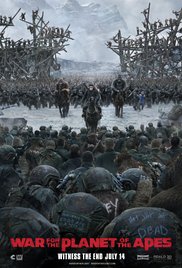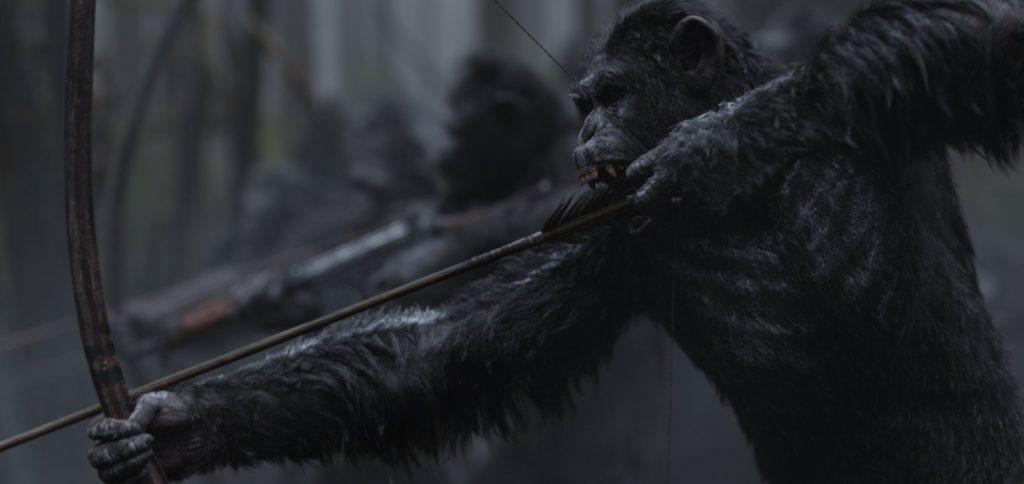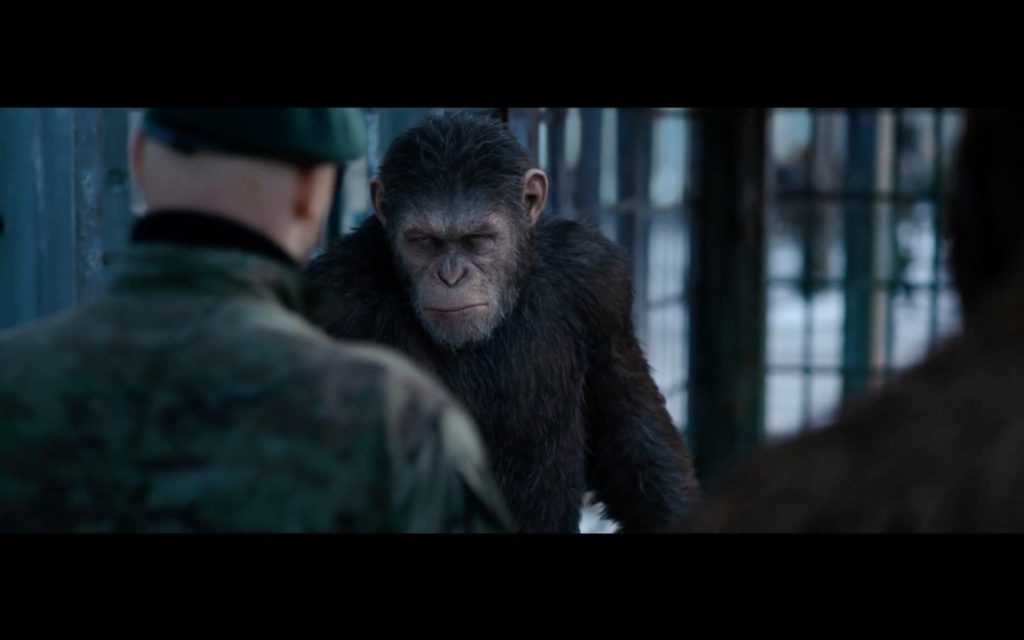Is This the Alpha and Omega of Smart Blockbusters?
DIRECTED BY MATT REEVES/2017
 Not to brag, but I named this movie.
Not to brag, but I named this movie.
Well, not really. As part of the conversation surrounding director Matt Reeves’ then-new second chapter in Fox’s franchise reboot Dawn of the Planet of the Apes, I stated that if and when a third film is made, it should be called “War for the Planet of the Apes“. Yes, I even called the “for” correctly. Not to brag or anything.
 In this chapter, the level-headed and most highly evolved ape leader Caesar is, early on, pushed beyond the limit of his tolerance for humans. Upstart contingents, in a last ditch effort to hold the planet for a mankind afflicted with a virus that renders them mute, have armed themselves into a militia. When losses at their hands become too great, Caesar (Andy Serkis, again terrific) and a handful of devoted followers venture from their village and into the desolate rural San Francisco landscape for most of the film. Their mission? To seek and destroy Woody Harrelson and his aggressive human forces.
In this chapter, the level-headed and most highly evolved ape leader Caesar is, early on, pushed beyond the limit of his tolerance for humans. Upstart contingents, in a last ditch effort to hold the planet for a mankind afflicted with a virus that renders them mute, have armed themselves into a militia. When losses at their hands become too great, Caesar (Andy Serkis, again terrific) and a handful of devoted followers venture from their village and into the desolate rural San Francisco landscape for most of the film. Their mission? To seek and destroy Woody Harrelson and his aggressive human forces.
This is the second monkey movie this year to directly reference Francis Ford Coppola’s modern classic Apocalypse Now, the first of course being the considerably more rip-roaring Kong: Skull Island. In War, we meet Woody Harrelson in full-on Col. Kurtz mode. He’s playing the fascistic leader of the human militia, a literal skinhead, and avowed human supremacist. He runs a tight ship in his dreary “ape-pocalypic” jungle compound. “Ape-pocalypse Now” is written prominently on a wall, should anyone miss the clear visual tie to Marlon Brando’s nightmarish base. Additionally , the ominous “alpha” and “omega” symbols that are spray painted onto the American flag and elsewhere may look vaguely familiar to fans of the classic series…

Steering this recent cycle of acclaimed, high-end Apes revivals more decidedly into the realm of being prequels rather than complete re-imaginings, War for the Planet of the Apes delivers quite a bit in the way of old-school references. This of course presumably moves things ever closer to the seminal 1968 original film, starring Charlton Heston.
What War for the Planet of the Apes lacks is a proper war. Eventually, Caesar and company end up in Harrelson’s internment camp for apes, until such a time that they can revolt and break free. Others have dubbed it “Great Escape From the Planet of the Apes“, which would make Caesar a de facto Steve McQueen, with a horse of course, in lieu of a motorcycle. The finale is well realized and gripping in its own right. Considering the somber, unapologetically slow pacing (perfect for this dismal in-between-societies wasteland of overgrowth and rubble), one could fairly call this a very rare “slow burn” of a summer visual effects blockbuster.

When, in 2014, I correctly speculated what the title would be, I quite incorrectly speculated on the storyline, imagining the sons of an aged Caesar going all King Lear on one another; a Ran style battlefield epic. That would’ve been thunderously cool, but this is nothing of the sort. Of course, it’s silly and wrongheaded to penalize a movie for not being what you thought it could’ve been. So, please believe me when I say that when this still-impressive and respectable sequel is, nonetheless, currently falling victim to that dread thing, overpraise.
Since the studio mandated embargo on reviews lifted, the world has been inundated with hyperbolic critical proclamations of War as something of pure genius. It is quite true that the ape motion capture visual effects are astounding, sometimes yielding hundreds of intelligent CGI simians without a hint of artifice. The only reason we know they’re not real is because they can’t be real. But the loudest critical voices have been proclaiming War as something of a Second Coming, an unforeseen stroke of brilliance. Methinks that this has more to do with external Trump-era anxieties, and how the themes and inky dark tone compliment that. Fact of the matter is that War is very much of a piece with Reeves’ previous series entry, Dawn of the Planet of the Apes.

In my opening weekend review of Dawn, I took the opportunity to lament the infiltration of such incredibly dark and self-seriousness into a summer blockbuster tent pole. I wrote that review before ever seeing the classic Apes sequels, Beneath the Planet of the Apes, Escape From the Planet of the Apes, Conquest of the Planet of the Apes, and Battle for the Planet of the Apes. Shortly thereafter, though, I did see them, learning that the series has a staunch history of downer endings and sober social and political themes. All three of the newer films, brandishing their own thematic weight popular in this Christopher Nolan era, certainly fit the tradition. Perhaps I was barking up the wrong tree in terms of choosing Dawn as my case-in-point for how films that should have aspects of fun have forsaken that tenant. Yet, the nagging feeling lingers, now with both Dawn and War, that the contemporary blend of amazing visual effects and inflated pop culture importance has ballooned too far. Yes, it’s true that War attempts a few moments of levity with a new, former zoo chimp called “Bad Ape” (Steve Zahn). As welcome as Zahn’s presence usually is in any film, this minor addition is kind of glaring and out of step.
War for the Planet of the Apes is, nonetheless, a 1.5 ton boat anchor of a film; the kind that is perpetually covered in flailing moss and tearing its way across the sea floor, dragged by a monstrously larger vessel. Such a thing is reliable, familiar and sturdy; but also terribly heavy. All of that said, War for the Planet of the Apes carries the torch of this respectable series, continuing onward in this thoughtful next chapter. It may not be the evolutionary leap that others are proclaiming it to be, but there’s plenty of relevant food for thought, excellent performances, and patient spectacle to satisfy mature filmgoers seeking something more on their multiplex excursions.
Will this strange critical darling yield a fourth entry into this current Ape-tastic cycle? The jury is not merely out on that one, it’s in the woods. One thing I do know, though – after this warless War, someone else can do the honors of naming the next one.

Courtesy of ZekeFilm Discussion Group on Facebook

